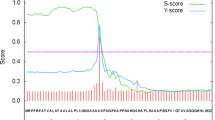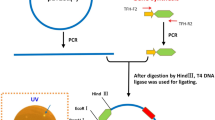Abstract
A metagenomic library containing ca. 3.06 × 108 bp insert DNA was constructed from a rice straw degrading enrichment culture. A xylanase gene, umxyn10A, was cloned by screening the library for xylanase activity. The encoded enzyme Umxyn10A showed 58% identity and 73% similarity with a xylanase from Thermobifida fusca YX. Sequence analyses showed that Umxyn10A contained a glycosyl hydrolase family 10 catalytic domain. The gene was expressed in Escherichia coli, and the recombinant enzyme was purified and characterized biochemically. Recombinant Umxyn10A was highly active toward xylan. However, the purified enzyme could slightly hydrolyze β-1,3/4-glucan and β-1,3/6-glucan. Umxyn10A displayed maximal activity toward oat spelt xylan at a high temperature (75°C) and weak acidity (pH 6.5). The K m and V max of Umxyn10A toward oat spelt xylan were 3.2 mg ml−1 and 0.22 mmol min−1 mg−1 and were 2.7 mg ml−1 and 1.0 mmol min−1 mg−1 against birchwood xylan, respectively. Metal ions did not appear to be required for the catalytic activity of this enzyme. The enzyme Umxyn10A could efficiently hydrolyze birchwood xylan to release xylobiose as the major product and a negligible amount of xylose. The xylanase identified in this work may have potential application in producing xylobiose from xylan.





Similar content being viewed by others
References
Ahmed S, Riaz S, Jamil A (2009) Molecular cloning of fungal xylanases: an overview. Appl Microbiol Biotechnol 84:19–35
Ali MK, Rudolph FB, Bennett GN (2005) Characterization of thermostable Xyn10A enzyme from mesophilic Clostridium acetobutylicum ATCC 824. J Ind Microbiol Biotechnol 32:12–18
Araki T, Tani S, Maeda K, Hashikawa S, Nakagawa H, Morishita T (1999) Purification and characterization of β-1,3-xylanase from a marine bacterium, Vibrio sp. XY-214. Biosci Biotechnol Biochem 63:2017–2019
Bachmann SL, McCarthy AJ (1991) Purification and cooperative activity of enzymes constituting the xylan-degrading system of Thermomonospora fusca. Appl Environ Microbiol 57:2121–2130
Belien T, Van Campenhout S, Robben J, Volckaert G (2006) Microbial endoxylanases: effective weapons to breach the plant cell-wall barrier or, rather, triggers of plant defense systems? Mol Plant-Microbe Interact 19:1072–1081
Collins T, Gerday C, Feller G (2005) Xylanases, xylanase families and extremophilic xylanases. FEMS Microbiol Rev 29:3–23
Daniel RM, Danson MJ, Eisenthal R (2001) The temperature optima of enzymes: a new perspective on an old phenomenon. Trends Biochem Sci 26:223–225
Degnan BA, Macfarlane GT (1991) Comparison of carbohydrate substrate preferences in eight species of Bifidobacteria. FEMS Microbiol Lett 68:151–156
Depiereux E, Feytmans E (1992) MATCH-BOX: a fundamentally new algorithm for the simultaneous alignment of several protein sequences. Comput Appl Biosci 8:501–509
Feng Y, Duan CJ, Pang H, Mo XC, Wu CF, Yu Y, Hu YL, Wei J, Tang JL, Feng JX (2007) Cloning and identification of novel cellulase genes from uncultured microorganisms in rabbit cecum and characterization of the expressed cellulases. Appl Microbiol Biotechnol 75:319–328
Fialho MB, Carmona EC (2004) Purification and characterization of xylanases from Aspergillus giganteus. Folia Microbiol (Praha) 49:13–18
Franco PF, Ferreira HM, Filho EX (2004) Production and characterization of hemicellulase activities from Trichoderma harzianum strain T4. Biotechnol Appl Biochem 40:255–259
Gibbs MD, Reeves RA, Bergquist PL (1995) Cloning, sequencing, and expression of a xylanase gene from the extreme thermophile Dictyoglomus thermophilum Rt46B.1 and activity of the enzyme on fiber-bound substrate. Appl Environ Microbiol 61:4403–4408
Gupta S, Bhushan B, Hoondal GS (2000) Isolation, purification and characterization of xylanase from Staphylococcus sp. SG-13 and its application in biobleaching of kraft pulp. J Appl Microbiol 88:325–334
Han SO, Yukawa H, Inui M, Doi RH (2004) Isolation and expression of the xynB gene and its product, XynB, a consistent component of the Clostridium cellulovorans cellulosome. J Bacteriol 186:8347–8355
Hayashi H, Abe T, Sakamoto M, Ohara H, Ikemura T, Sakka K, Benno Y (2005) Direct cloning of genes encoding novel xylanases from the human gut. Can J Microbiol 51:251–259
Henrissat B (1991) A classification of glycosyl hydrolases based on amino acid sequence similarities. Biochem J 280(Pt 2):309–316
Hu Y, Zhang G, Li A, Chen J, Ma L (2008) Cloning and enzymatic characterization of a xylanase gene from a soil-derived metagenomic library with an efficient approach. Appl Microbiol Biotechnol 80:823–830
Jiang ZQ, Deng W, Zhu YP, Li LT, Sheng YJ, Hayashi K (2004) The recombinant xylanase B of Thermotoga maritima is highly xylan specific and produces exclusively xylobiose from xylans, a unique character for industrial applications. J Mol Catal B: Enzymatic 27:207–213
Kim DY, Han MK, Lee JS, Oh H-W, Park D-S, Shin D-H, Bae KS, Son K-H, Park H-Y (2009) Isolation and characterization of a cellulase-free endo-β-1,4-xylanase produced by an invertebrate-symbiotic bacterium, Cellulosimicrobium sp. HY-13. Proc Biochem 44:1055–1059
Kulkarni N, Lakshmikumaran M, Rao M (1999) Xylanase II from an alkaliphilic thermophilic Bacillus with a distinctly different structure from other xylanases: evolutionary relationship to alkaliphilic xylanases. Biochem Biophys Res Commun 263:640–645
Kuske CR, Banton KL, Adorada DL, Stark PC, Hill KK, Jackson PJ (1998) Small-scale DNA sample preparation method for field PCR detection of microbial cells and spores in soil. Appl Environ Microbiol 64:2463–2472
Li C, Hong Y, Shao Z, Lin L, Huang X, Liu P, Wu G, Meng X, Liu Z (2009) Novel alkali-stable, cellulase-free xylanase from deep-sea Kocuria sp. Mn22. J Microbiol Biotechnol 19:873–880
Mamo G, Hatti-Kaul R, Mattiasson B (2006) A thermostable alkaline active endo-β-1,4-xylanase from Bacillus halodurans S7: purification and characterization. Enz Microb Technol 39:1492–1498
Miller GL (1959) Use of dinitrosalicylic acid reagent for determination of reducing sugar. Anal Chem 31:426–428
Okazaki M, Fujikawa S, Matsumoto N (1990) Effect of xylooligosaccharides on growth of Bifidobacterium. J Jpn Soc Nutr Food Sci 43:395–401
Polizeli ML, Rizzatti AC, Monti R, Terenzi HF, Jorge JA, Amorim DS (2005) Xylanases from fungi: properties and industrial applications. Appl Microbiol Biotechnol 67:577–591
Reinhold-Hurek B, Hurek T, Claeyssens M, van Montagu M (1993) Cloning, expression in Escherichia coli, and characterization of cellulolytic enzymes of Azoarcus sp., a root-invading diazotroph. J Bacteriol 175:7056–7065
Saha BC (2003) Hemicellulose bioconversion. J Ind Microbiol Biotechnol 30:279–291
Shallom D, Shoham Y (2003) Microbial hemicellulases. Curr Opin Microbiol 6:219–228
Subramaniyan S, Prema P (2002) Biotechnology of microbial xylanases: enzymology, molecular biology, and application. Crit Rev Biotechnol 22:33–64
Sunna A, Antranikian G (1997) Xylanolytic enzymes from fungi and bacteria. Crit Rev Biotechnol 17:39–67
Sunna A, Bergquist PL (2003) A gene encoding a novel extremely thermostable 1,4-β-xylanase isolated directly from an environmental DNA sample. Extremophiles 7:63–70
Torronen A, Rouvinen J (1997) Structural and functional properties of low molecular weight endo-1,4-β-xylanases. J Biotechnol 57:137–149
Widdel F, Bak F (1992) Gram-negative mesophilic sulfate-reducing bacteria. In: Balows A, Trüper HG, Dworkin M, Harder W, Schleifer K-H (eds) The prokaryotes. Springer, New York, pp 3352–3378
Yamada K, Terahara T, Kurata S, Yokomaku T, Tsuneda S, Harayama S (2008) Retrieval of entire genes from environmental DNA by inverse PCR with pre-amplification of target genes using primers containing locked nucleic acids. Environ Microbiol 10:978–987
Zhang GM, Huang J, Huang GR, Ma LX, Zhang XE (2007) Molecular cloning and heterologous expression of a new xylanase gene from Plectosphaerella cucumerina. Appl Microbiol Biotechnol 74:339–346
Zhou J, Bruns MA, Tiedje JM (1996) DNA recovery from soils of diverse composition. Appl Environ Microbiol 62:316–322
Acknowledgments
This work was supported by grants from the Ministry of Science and Technology of China (2009DFA30700) and the National Hi-tech Research and Development Program of China (863 Program 2007AA021307).
Author information
Authors and Affiliations
Corresponding author
Electronic supplementary materials
Below is the link to the electronic supplementary material.
ESM 1
(DOC 369 kb)
Rights and permissions
About this article
Cite this article
Mo, Xc., Chen, Cl., Pang, H. et al. Identification and characterization of a novel xylanase derived from a rice straw degrading enrichment culture. Appl Microbiol Biotechnol 87, 2137–2146 (2010). https://doi.org/10.1007/s00253-010-2712-2
Received:
Revised:
Accepted:
Published:
Issue Date:
DOI: https://doi.org/10.1007/s00253-010-2712-2




